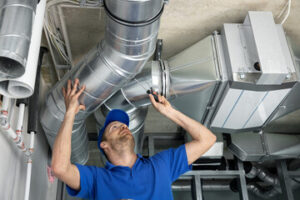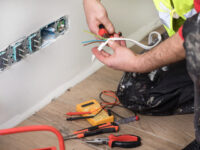Heating Systems
A heating system transfers thermal energy to air to warm your home. Natural gas, propane, fuel oil, or electricity can be used as heat sources.
Energy-efficient systems require fewer cycles over their lifespans. Too many processes cause a lot of wear and tear on parts such as compressor motors. Read https://comfortprosheatandair.com/ to learn more.

The boiler, or steam heater, is essential to your home heating system. It heats water or any other liquid inside it until it becomes vaporized and is used to warm the rooms in your house. There are many boilers, each designed to meet specific heating needs.
Most boilers use natural gas as the main fuel source but can also be powered by other types of energy, such as oil or coal. The fuel is combusted in a combustion chamber, and the hot gases pass through a heat exchanger to transfer some of their energy into the liquid water or steam. The heat exchanger is typically made from steel or cast iron to withstand the high temperatures inside the boiler.
Once the water or steam is heated, it passes through a series of pipes in your house, warming up your baseboards, radiators, or radiant floor heating systems. You can use a traditional boiler to heat your entire property or a system that heats only the water you use for showering and cooking. The method you choose will depend on your preferences and budget.
The key difference between a boiler and a furnace is how they produce warmth. A boiler uses a system of pipes to circulate hot water and steam throughout your property, while a stove uses ductwork to distribute heated air. A boiler is a more cost-effective heating method because it produces and distributes heat consistently.
There are several different controls that you can use to control your boiler, depending on the type of heating system you have in your home. Most conventional boilers will have a programmer that you can set to turn your heating and hot water on and off at certain times of the day, as well as a thermostat to monitor the temperature in your room and automatically adjust it. A combination boiler will have a programmer for both heating and hot water and will be fitted with a cylinder thermostat to control the temperature of your hot water tank.
The furnace is the heart of any home heating system. It takes cold air from outside and heats it to be blown throughout the home. Any furnace has five key components: the thermostat, burners, heat exchanger, blower motor, and home ductwork.
The first step in the heating cycle occurs when the thermostat detects a difference between its settings and the indoor air temperature. That signals to the furnace that the home needs heat, which signals the ignition switch to fire the burners. There are two types of fuels used in furnaces: gas and oil. Most modern systems use a combination of propane and natural gas, but there are also oil-burning furnaces. Regardless of the type of fuel, the same basic steps occur.
Once the burners are fired up, a draft hood and fan pull outside air into the system, mixing it with the hot gas inside the furnace to create combustion. A heat exchanger converts the combustion byproducts into warm air dispersed throughout your home via ductwork. In the case of non-condensing furnaces, this is done through a flue that vents outside the home. In the case of condensing furnaces, exhaust gases are directed to a second heat exchanger where they cool and condensation occurs, which then combines with the hot air from the primary exchanger and circulates through your ductwork.
The blower motor, which can be either electric or gas, then blows the conditioned air into your ductwork to distribute it throughout the house. Several different fan speeds are available to control the amount of conditioned air produced and increase efficiency. Still, all have one thing in common: they direct conditioned air toward your thermostat to keep it in your preferred setting.
During the heating cycle, the thermostat will continue to check its setting and signal the furnace when it reaches its desired location. If the thermostat is turned off, the gas valve will close to prevent the flow of gas, and the flame sensor, designed to avoid a dangerous build-up of gas if the igniter fails, will also shut off the flow of air. The system will then cool, preparing for the next call for heat from your thermostat.
Unlike boiler heaters, which can only heat your home in the winter, air conditioners also provide cooling. They work by blowing cool air across a series of chilled pipes, causing the water in the line to evaporate and cool down. The cool air flows back through the house and through ductwork, which is blown into the rooms via registers. This cooling process also helps to remove any moisture that may be in the ductwork.
Air conditioning is typically a forced air system, but some ductless systems are also available. Ductless air conditioners, sometimes called mini-splits, offer a heating and cooling solution for homes without ductwork or for use in rooms that cannot accommodate ductwork.
The basic workings of an air conditioner are based on the second law of thermodynamics, which states that heat always moves from warmer to cooler objects until they reach a state of equilibrium. Air conditioners take advantage of this principle by using a special chemical called refrigerant that circulates through the system’s coils to absorb thermal energy from the air in your house and reject it to the outdoor unit, where it changes from a liquid to a gas, which allows it to transfer heat much more efficiently than it could as a liquid.
On the other hand, a centralized air conditioner is comprised of two separate units – the condenser unit and the evaporator unit – connected by refrigerant tubing. The evaporator unit is located inside your house, where the air is heated and cooled before being distributed throughout your home through a network of ductwork.
Central systems are typically more expensive to install than split systems, but they can save you money over time with their high efficiency. They are generally the best option for homeowners with older homes or those who want to control the temperature of individual rooms.
A heat pump exploits natural laws of physics to transfer energy from the air outside to the inside of your home. It uses an outdoor unit, an indoor air handler (ducted or ductless), and a refrigerant cycle. This vapor-compression system also features a reversing valve and optimized heat exchangers to change the direction of thermal energy flow to deliver heating and cooling.
When operating in heating mode, a heat pump’s reversing valve switches the refrigerant flow. It then draws warmth from the air, even in very cold climates. The refrigerant passes through a coil that operates as a condenser in cooling mode or an evaporator in heating mode, depending on the current operational setting of the reversing valve. A fan blows outdoor air over the coil to facilitate heat exchange.
Heat pumps are more efficient than most other heating systems, especially those that run on fossil fuels. They are also a much safer choice than gas furnaces, which can be prone to carbon monoxide poisoning.
The HSPF rating, which considers supplemental heating needs and defrost energy, is an important metric for choosing a heat pump. A high HSPF means the system can efficiently heat your home in almost any weather. They’ll know how to spot problems that you might not be able to see. That is especially true for an issue that could be buried inside piping or in the unit itself.
If you’re considering upgrading your existing heating system, consider adding an ENERGY STAR-certified air-source heat pump. It provides cool air in the summer and can offset some of your heating costs in winter. Just be sure to have a professional load calculation done using an AC Contractors of America-approved method, like Manual J, before putting in a new heat pump. It will help ensure the system is properly sized for your house to maximize efficiency.





